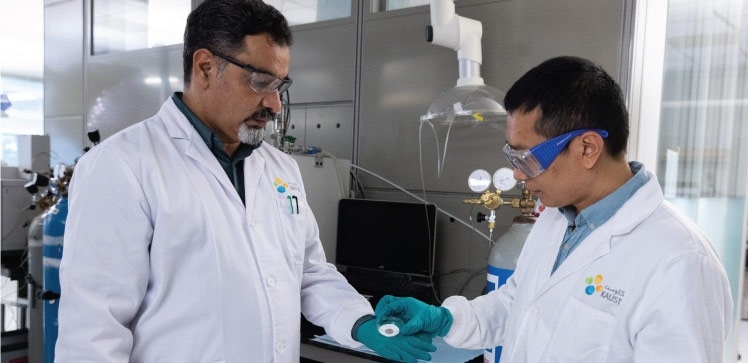At present, it is possible to isolate impure chemical mixtures depending on variations in molecular silhouette. Membranes have been fabricated with the help of nanoscale pores that correspond to the shape of impurities in the mix so that only the impurity can pass through.
 Osama Shekhah (left) and Jiangtao Jia inspect their metal-organic framework membrane that can remove nitrogen from natural gas much more efficiently than current standard removal methods. Image Credit: © 2022 KAUST.
Osama Shekhah (left) and Jiangtao Jia inspect their metal-organic framework membrane that can remove nitrogen from natural gas much more efficiently than current standard removal methods. Image Credit: © 2022 KAUST.
At the King Abdullah University of Science and Technology (KAUST) scientists have suggested that the first application of such metal-organic framework (MOF) based shape-selective membranes could be the affordable and energy-efficient purification of natural gas.
MOFs are referred to as organic–inorganic hybrid crystalline porous materials that have the potential to feature various kinds of pores via their structure. By building MOFs from various organic and inorganic building blocks, scientists can tune the pore structure and aperture in a fine manner.
MOF membranes have previously displayed huge potential for isolating mixtures of molecules depending on variations in their polarizability or size.
Natural gas, also called methane, has been forecasted to play a highly significant role in the global energy supply at the time of the transition to renewables. Nearly all natural gas reservoirs have been contaminated with nitrogen.
The nitrogen dilutes the heating value of natural gas, so it has to be removed.
Sheng Zhou, PhD Student, King Abdullah University of Science and Technology
Sheng Zhou, a Ph.D. student in Mohamed Eddaoudi’s lab, led the research.
Nitrogen is chemically inert and similar in both polarizability and kinetic shape to methane. Hence, it is not possible to remove it using present membranes.
For industrial natural gas purification, there needs to be nitrogen rejection units based on cryogenic distillation.
Sheng Zhou, PhD Student, King Abdullah University of Science and Technology
This method of ultra-low temperature separation is energy-intensive and high-priced.
Eddauodi, Zhou, and their collaborators have come up with a highly effective MOF-based technique to purify methane.
We designed a porous membrane that separates nitrogen from methane by exploiting one significant difference between the molecules: their shape.
Sheng Zhou, PhD Student, King Abdullah University of Science and Technology
While nitrogen consists of a rod-like linear structure, methane exhibits a triangular trefoil-type profile. The team engineered a new membrane material, called Zr-fum67-mes33-fcu-MOF, along with asymmetric pores shaped accurately to block methane but enable nitrogen penetration.
At present, the team has displayed that, in comparison to cryogenic separation, the shape-selective MOF decreased purification costs by 66% for a methane stream consisting of 15% nitrogen.
Furthermore, other possible impurities could be eliminated. For methane that has been contaminated with nearly 15% nitrogen and 35% carbon dioxide, the purification cost was decreased by around 73%.
“We saw a massive reduction in total purification cost when the membrane was used,” stated Osama Shekhah, a senior research scientist in Eddaoudi’s lab.
So far, shape difference in molecular mixtures has been neglected in a huge way.
Eddaoudi stated, “Shape-mismatch induced separation is a totally new separation mechanism. Once people focus on shape-mismatch separation, they may find many chemical mixtures, such as linear and branched hydrocarbons or aromatic chemicals, that could be efficiently separated using this concept.”
Shaping the future of purification
KAUST researchers have developed a MOF membrane that can purify natural gas. Video Credit: © 2022 KAUST.
Journal Reference:
Zhou, S., et al. (2022) Asymmetric pore windows in MOF membranes for natural gas valorization. Nature. doi.org/10.1038/s41586-022-04763-5.